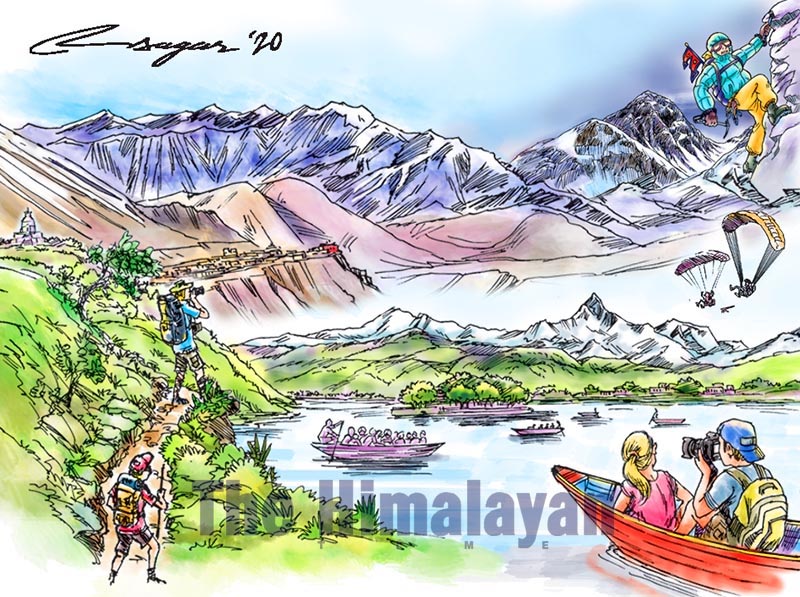Visit Nepal Year 2020: Let’s promote homestays
The main objective of this venture is to draw 40 per cent of tourists to the villages, let the locals take the initiative to promote their own destinations and thereby reap the benefits from the tourism hospitality
Tourism is one of the most important engines of economic growth and development. As per the data published by the World Travel and Tourism Council (WTTC), the tourism industry now accounts for 10 percent of the world’s gross domestic product (GDP) and employs 319 million people all over the world. The latter figure is expected to reach 421 million by 2029. This means that tourism is not only an economic growth engine, but also a growing employment engine in itself.
Tourism generates and employs a large workforce and does so in an inclusive manner providing great opportunities for both genders, even creating jobs for young people. It is estimated that worldwide and, on average, 55 per cent of employment in the tourism industry is women.
Considering its contribution over time, no country can be indifferent to tourism. Accordingly, many countries have done what they reasonably could to increase their share of investment in this industry, including strategies and campaigns to highlight the attractiveness of their preferred destinations to enjoy which visitors come from far away to this corner of the globe. One such campaign is the current Visit Nepal Year 2020. The stated objective of it is to bring in 2 million tourists with a targeted daily spending of USD 75. For this, international promotion and publicity campaigns are very important and essential but tourism is such a business that needs promotion both internally and internationally.
Internal tourism must be promoted because if local people don’t know what is tourism, who the tourists are, why and how they must be treated tourism isn’t likely to flourish. Likewise, if our tourism industry isn’t promoted overseas, it won’t help increase the number of tourists and the duration of their stay in our country. It is a fact that whatever importance we attach to tourism, especially international tourism, it is certainly not the main source of livelihood of many Nepalis and communities. Many people in Nepal are engaged in farming, raising livestock and only a few are engaged in tourism businesses.
The Nepali people have a unique relationship with nature and the local environment that can be observed from their everyday interactions with land and forest products for their firewood, building materials, fodder and trees.
Poor people care more about their survival than their welfare or recreational needs. Women and disadvantaged groups in particular who have been like proverbial frogs in the well and have rarely travelled outside their respective villages have no idea of who the tourists are and what to expect from them. What they normally do is to sell their surplus products at local bazaars and they have no idea how to approach the visitors. Many people in villages reckon that tourism is a big business not within their reach but run by rich and wealthy people of Kathmandu, Pokhara and a few other metropolitan cities only.
It is true that most businesses are capital intensive requiring a huge investment in order to get handsome returns. The average Nepalis can hardly afford to do so. Yet tourism is one such enterprise that can be run by investing not that much. This can be done by giving a warm welcome to the tourists in their own homes and by creating a homely atmosphere to both internal and international visitors. So it isn’t without reason that the government has brought in the concept of homestays that allows local communities to welcome tourists in their own homes provided they meet the specifications and guidelines set.
Learning from the experiences of Malaysia, South Korea and in consultations with tourism experts, entrepreneurs and other stakeholders, the government is actively seeking the promotion of this tourism product in Kathmandu, Kavre, Sankhuwasabha, Palpa, Chitwan and many other areas of Nepal. The main objective of this venture is to draw 40 per cent of tourists to the villages, let the locals themselves take the initiative to promote their own destinations and thereby reap the benefits from the tourism hospitality that has hitherto enjoyed by tourism entrepreneurs of the metropolitan cities and a network of international companies.
Homestays have the potential of enhancing employment, augmenting income of the local communities and thereby raising the standards of living at the local level.
One of the main reasons why tourism hasn’t been able to contribute as much to our local economy is an apathy shown by the political parties towards this sector except during these campaigns which are launched from time to time. Nepal launched Tourism Year 2011 with the slogan “Together for Tourism” which wasn’t the first of its kind as Year 1998 had also been declared as Visit Nepal Year and so was 2002/3 that was launched as ‘Destination Nepal’ campaign that was in addition to Nepal Tourism Board (NTB) campaign, “Naturally Nepal...Once isn’t enough” and government’s campaign, “Send home a friend and Nepal for all seasons”.
Thanks to our unmatched comparative advantage in nature-and culture-based tourism as well as friendliness and hospitality of the people, Nepal has been able to attract tourists even in years of crises like the decade-long conflict when tourists kept coming despite political upheaval and instability.
Nevertheless, it doesn’t mean that it isn’t necessary for political parties to adapt the industry over and over to meet the demands of the new times and consumers.






